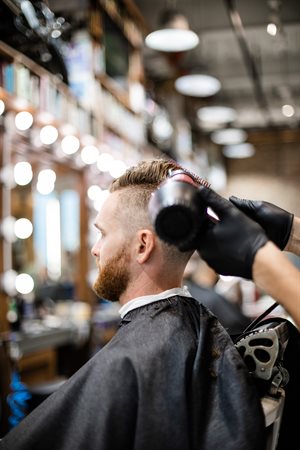Managing the Risk of Ringworm in Hairdressing and Barbering
Ringworm of the scalp area, or Tinea capitis, is a fungal infection that can spread easily in the hairdressing and barbering industry if poor infection control measures are being used.
The infection can spread easily through close contact with an infected person or object, including equipment or tools being used on more than one client. If left untreated, Ringworm can spread to other areas, cause scarring and hair loss. Treatment usually requires taking prescription anti-fungal medications for one to three months.
more than one client. If left untreated, Ringworm can spread to other areas, cause scarring and hair loss. Treatment usually requires taking prescription anti-fungal medications for one to three months.
How do I know what to look out for?
Common signs of Ringworm infection include:
- One or more round, scaly or inflamed areas of skin
- Itchy skin
- Patches of hair that has broken off at, or near, the scalp
The British Master Barbers website explains more about infections and scalp/skin conditions along with advice about barbering practice:
How do I ensure I’m not putting my customers, and employees, at risk?
 Effective cleaning and disinfection arrangements are critical for preventing, or controlling, the spread of bacterial, viral or fungal infections amongst your workers and customers. As a starting point, you should review your current procedures for disinfecting hair cutting equipment and tools to ensure they are fit for purpose.
Effective cleaning and disinfection arrangements are critical for preventing, or controlling, the spread of bacterial, viral or fungal infections amongst your workers and customers. As a starting point, you should review your current procedures for disinfecting hair cutting equipment and tools to ensure they are fit for purpose.
Ensure that the products, and methods, used to disinfect your equipment (including clippers) are effective against a range of micro-organisms. Many anti-bacterial sprays do not have fungicidal properties and will not prevent the spread of Ringworm infection. Aim to select a product that has anti-bacterial, virucidal and fungicidal properties and is appropriate for hair cutting equipment (i.e. won’t cause corrosion). Product such as Barbicide liquid and Clippercide spray have fungicidal properties. Further information and training is available on the Barbicide website.
You must ensure that cleaning products are used at the correct concentration (dilution) and are applied for the contact time specified by the manufacturer on equipment such as cut throat razors, scissors, combs, clippers, and cutting guides/clipper guards each time they are used. Equipment should be disinfected at the start of the day/shift and after use on every client.
Aim to have multiple items of hair cutting equipment, such as scissors, clippers and combs, available on site so that some can be undergoing disinfection whilst others are in use. For disinfection to be effective, the Manufacturer’s instructions must be followed (including instructions regarding fresh solutions).
What should I do if a client has signs of an infection?
 Before cutting a client’s hair, you should check for any signs of a suspected infection and discuss concerns with the client. In some circumstances it may be appropriate for you to decline to cut a client’s hair on infection control grounds.
Before cutting a client’s hair, you should check for any signs of a suspected infection and discuss concerns with the client. In some circumstances it may be appropriate for you to decline to cut a client’s hair on infection control grounds.
If you discover a client has a suspected infection mid hair-cut, you need to have a contingency plan in place. This should include:
- thorough hand washing and drying; the use of suitable gloves to provide a barrier
- separation of the equipment used on the client for thorough disinfection
- thorough clean down and disinfection of the area; and advise the client to consult a doctor or other specialist about diagnosis and treatment.
Other infection prevention and control measures to put into practice:
- Use fresh, clean towels on each client and freshly cleaned, or disposable, gowns.
- Dry your hands thoroughly after hand washing with soap and warm/hot water.
- Change your gloves (if used) between clients, and wash your hands between glove changes.
- Check your skin regularly for early signs of skin problems
- Keep the workplace well ventilated
Use of Clippercide
The following steps must be carried out between clients:
- Thoroughly clean clipper blades removing any organic soiling.

- Hold can upright approximately 15-20cm from surface, ensuring clippers are off.
- Spray Clippercide through teeth of clipper blades, covering all surfaces.
- Keep surfaces moist for 10 minutes.
- Allow to air dry before using the clippers on the next client.
Use of Barbicide to disinfect re-usable tools and equipment

- Make a fresh solution of Barbicide daily, or more often if visibly dirty.
- Mix 60ml of Barbicide in 1 litre of water to achieve a dilute rate of 16:1
- Thoroughly clean all hard surfaced, non-porous items of equipment prior to immersion in the Barbicide solution.
- Immerse the pre-cleaned items of equipment in the Barbicide solution for at least 10 minutes.
- Rinse all items of equipment, and hygienically dry, before re-using it.
The above information is provided to you in the interests of public health and to assist you in ensuring compliance with health and safety requirements in hairdressing and barbering